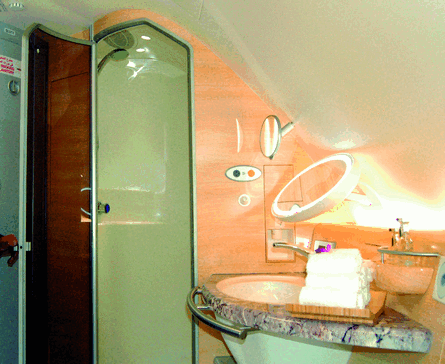The amount of water being consumed by the showers on board Emirates' Airbus A380s is much lower than expected, allowing the airline to examine a significant reduction in the uplift for each flight. The savings may also allow the auxiliary water tanks specified for the aircraft to be removed.
Emirates Airline president Tim Clark revealed when the first A380 was delivered in July that based on a forecast of usage of the two on-board showers by first-class passengers, the aircraft would have to carry around 500kg (1,100lb) - or 25% - more water. The airline's A380 first-class cabin features 14 suites.
To cater for the showers, the airline's 489-seat A380s are fitted with two optional auxiliary potable water tanks installed in the centre wingbox, which increases capacity from the standard 1,700 litres (450USgal) capacity in six tanks to 2,270 litres - ie around 2.3t.
 |
|---|
© Emirates |
Clark says now that after operational experience with the first two aircraft on the 14h Dubai-New York route, the indications are that the airline may have been over cautious in its calculations: "We're seeing 75% of the first-class seat load factor using the showers, and the actual total consumption on the 14h sector is 1.2-1.3t. We've been landing with 1.2t of water in the tank.
Clark attributes the original over-estimate on water requirements to the fact that the calculations were based on the airline's experience with its A340-500s. "We hadn't taken into account properly that the A380 has new distribution technology which delivers the water more efficiently," he says.
The initial plan is to use the savings to recalculate and reduce the water uplift requirement for each flight. "We're examining whether we can remove around 1t of water," says Clark, adding that in the longer term, "we could take a look at removing the extra water tanks once we reach maturity on the aircraft. This would reduce weight and give us better efficiency."
Clark says that the weight savings from the reduction in water uplift - and the eventual tank removal - will either reduce fuel burn or boost payload. "It gives us around 3t more of commercial payload," he says.
Emirates has two A380s in service, with the third due to arrive imminently - around 16 days late, says Clark. The fourth aircraft is due in December and the fifth in February, although Clark concedes that he expects this will probably slip to March.
The airline will add its second destination to the A380 network on 1 December, with the launch of Dubai-London Heathrow services. Clark says the flights are fully booked through December and into January. Services from Dubai to Sydney and Auckland will begin in February.
Source: Flight International



















